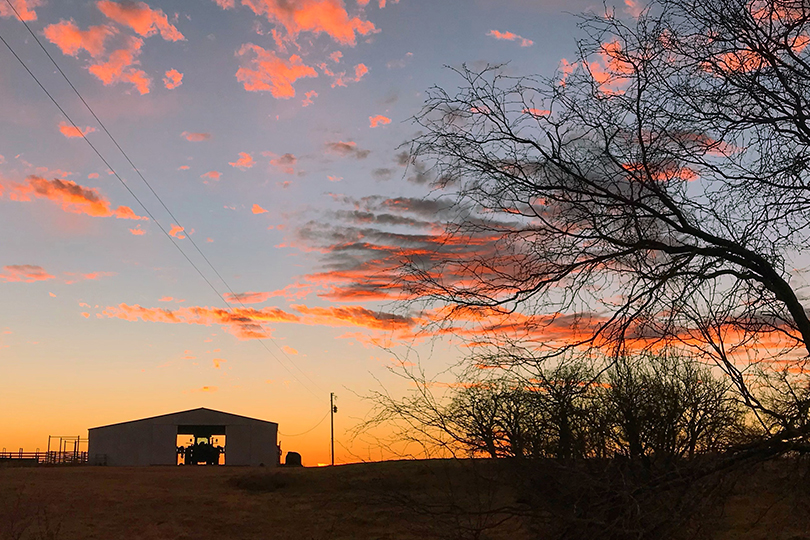By Jennifer Whitlock
Field Editor
Farming and ranching can be incredibly stressful occupations because so much of a farmer or rancher’s livelihood depends on factors completely outside their control.
One bad weather event can wipe out years of hard work overnight, and commodity prices are often near or below production costs. And the pandemic has taken a huge toll on the agricultural community.
What happens when feelings of depression, stress or anxiety become overwhelming?
Some people visit a general practitioner for guidance. Others reach out to a mental health care professional. But some farmers and ranchers continue to suffer through a mental health crisis in silence.
“Stigma, cultural norms, the power of the grapevine in rural communities where folks don’t want other people to know when they’re accessing services…all these factors contribute to a large portion of rural residents not getting help when they need it,” Dr. Carly McCord, director of Telebehavioral Health and clinical assistant professor at Texas A&M University College of Medicine, said.
Recent surveys show support for a change in attitude and how rural residents address mental health.
An overwhelming majority, or 87 percent, of farmers and farmworkers said it is important to reduce stigma about mental health in the agricultural community, including 59 percent who said it is very important, according to an American Farm Bureau Federation poll.
The same poll identified the main barriers to seeking help or treatment as cost, availability, accessibility, stigma and embarrassment.
Providers across Texas are working to close some of those gaps through programs like the one McCord oversees at Texas A&M.
Increasing availability and accessibility of services in rural areas is one of her top research areas of focus, and something she has been studying since she was a graduate student.
“We went from a hub-and-spoke model for behavioral telehealth, where folks came to an access point or ‘spoke,’ and our counselors used to come here on campus to our hub site. While that has its benefits, including guaranteed patient access to reliable internet and technology, it also forces people to leave the home. Unfortunately, there were folks who still couldn’t leave the home for a variety of reasons,” she said. “For years, we didn’t really have the technology to help them. We could just do an audio call by phone. It’s really only recently that we have platforms that are secure and that can be used from any mobile device.”
Now, direct-to-consumer in-home care is becoming more standardized and accepted by most major health insurance companies. The silver lining of the pandemic is that it’s helping to accelerate that shift.
“It’s exciting. That’s person-centered care. Patients don’t have to come onto our turf anymore and meet on our terms. It can drastically reduce travel costs and the time it takes,” McCord said. “You can call in on your lunch break or take a break at work. It makes things so much more accessible bringing them directly to the person, and I’m excited to see how much of this telehealth use and reimbursement persists beyond the pandemic. Because we know we can continue to reach people in need this way.”
Mental health providers are looking at ways to get general practitioners—often the only health care professionals in a county or region—involved, too.
“We’re in the early stages of incorporating additional mental health training and integrating behavioral health into primary care, because primary care is the first line where people seek treatment,” McCord said. “Something like 80 percent of mental health issues are treated first in primary care. They’re the ones seeing anxiety and depression in patients, so we’re working to improve training and standards in this area.”
McCord noted one of the main ways to help reduce stigma is increasing mental health literacy.
“Instead of thinking, ‘Well, if you’d just done something differently,’ or ‘Just pull yourself up by your boots, you’ll be fine,’ we need to really work toward getting everyone to understand that there are biological and physiological components to mental health,” she said.
Reach out to someone who appears to be suffering.
“It really is okay to ask how other people are doing, to ask specifically, ‘Are you thinking about suicide?’” she said. “The more that we all talk about when we’re not okay, and are willing to be vulnerable with others, the better off we’re all going to be, because there is help out there.”
If you’re the one suffering, there are resources to help.
“Please reach out for help. We know that counseling and mental health help is effective. Often, things like depression and anxiety don’t last forever in terms of episodes, but they need attention,” she said. “If you’re having thoughts of suicide, that’s a good alarm bell that you’re feeling overwhelmed. Please, please take some steps to reach out and get help because there is hope. And you’re definitely not alone.”
American Farm Bureau Federation has information and resources regarding rural mental health on its Farm State of Mind webpage. Also available online is the Rural Resilience Training, a free workshop to train individuals to understand sources of stress, identify communication strategies to reach those in need, reduce stigmas and learn warning signs of stress and suicide.

